Abstract
The in vitro antibacterial activity of E-3846, a new fluoroquinolone carboxylic acid derivative with a pyrrol ring substituent at position 7, was evaluated in comparison with norfloxacin and ciprofloxacin. E-3846 was more active than the reference quinolones against Staphylococcus species, including methicillin-resistant strains. E-3846 was similar to ciprofloxacin and more active than norfloxacin against Streptococcus (Enterococcus) faecalis. In general, E-3846 was more active than norfloxacin against members of the family Enterobacteriaceae, but less active than ciprofloxacin. For Pseudomonas aeruginosa, the MICs giving 90% inhibition for E-3846, norfloxacin, and ciprofloxacin were 2, 1, and 0.25 micrograms/ml, respectively. The activity of E-3846 increased at acid pH; in contrast, acid pH caused a pronounced decrease in the activity of norfloxacin and ciprofloxacin. In vivo, E-3846 demonstrated excellent therapeutic efficacy in treating experimental S. faecalis, Escherichia coli, Klebsiella pneumoniae, Proteus mirabilis, and Pseudomonas aeruginosa cystitis and pyelonephritis in rats.
Full text
PDF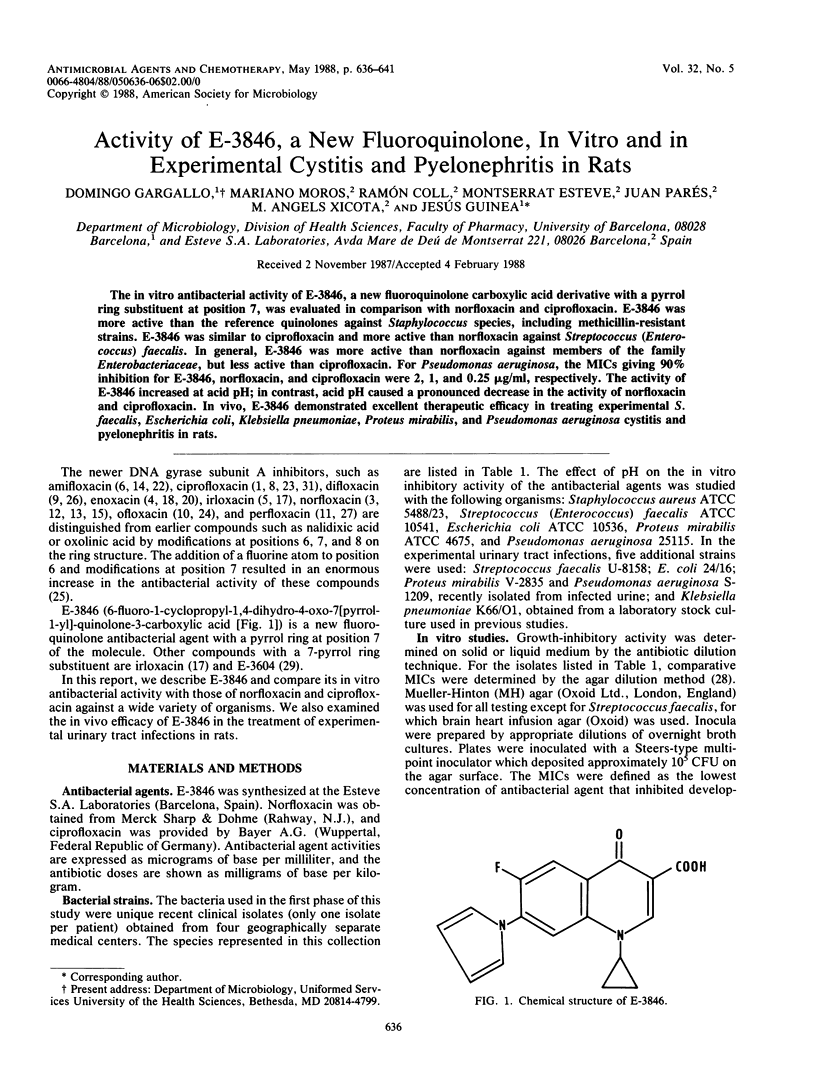
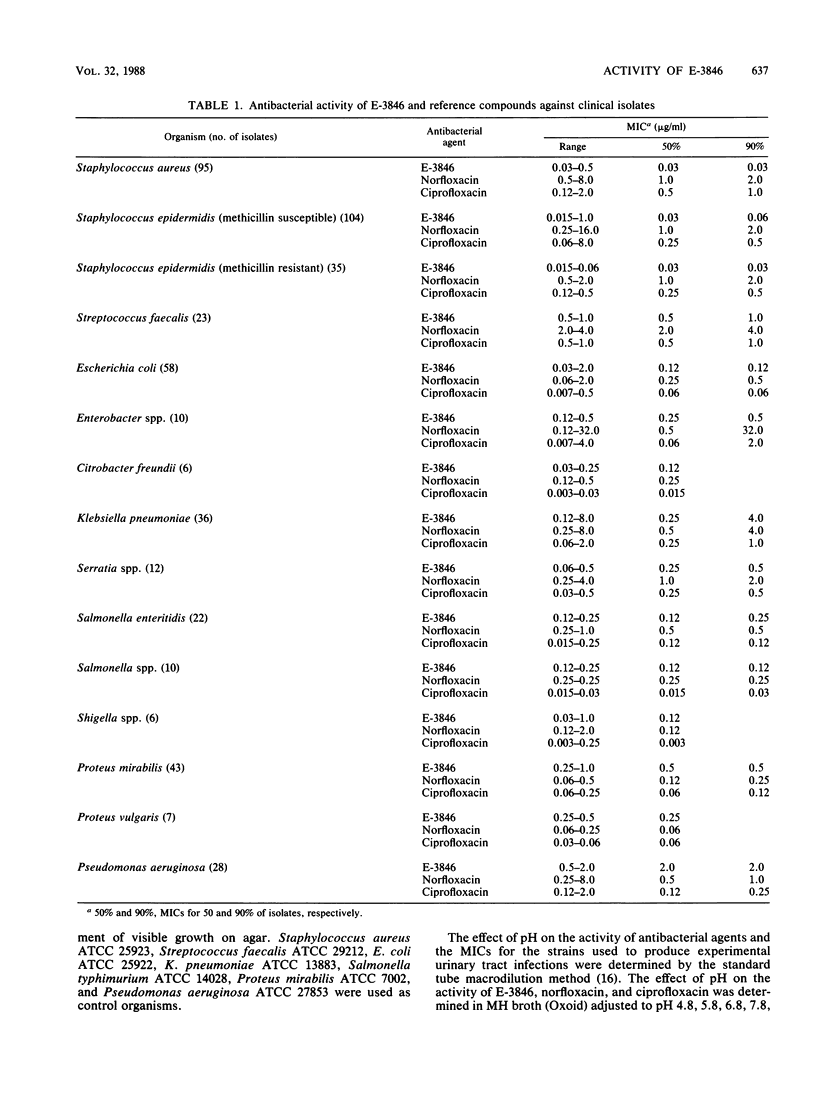
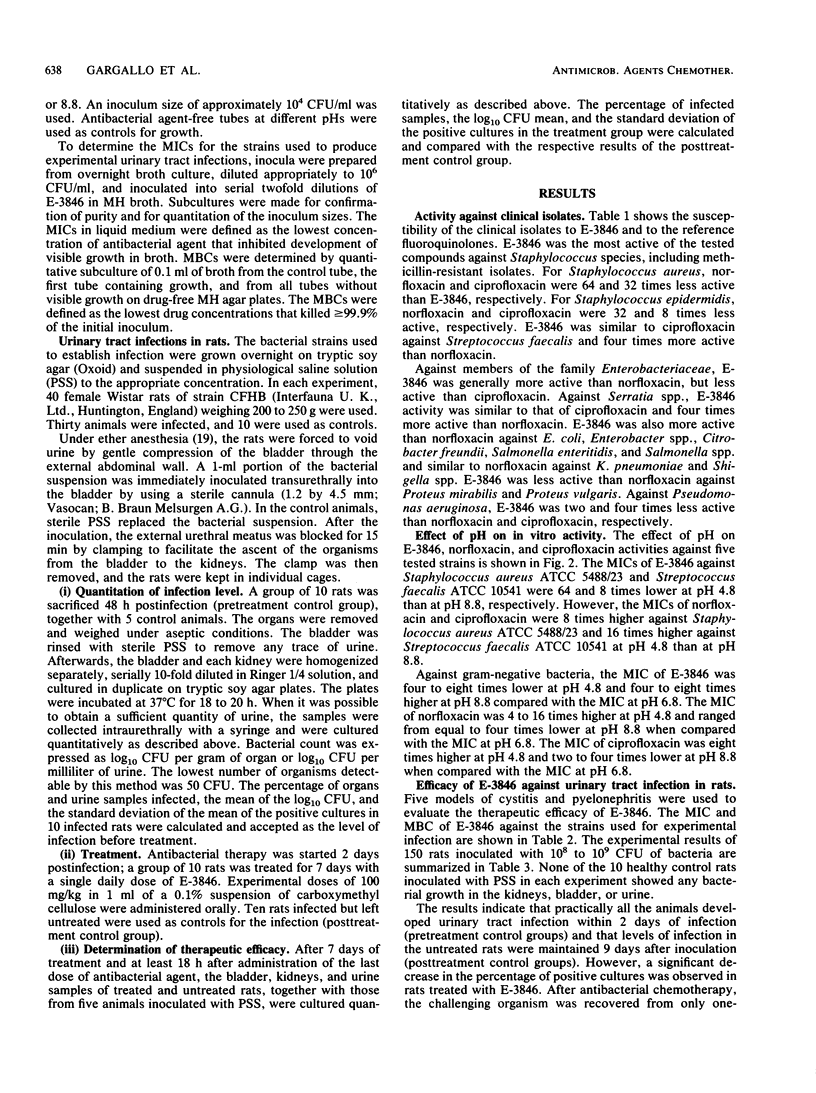

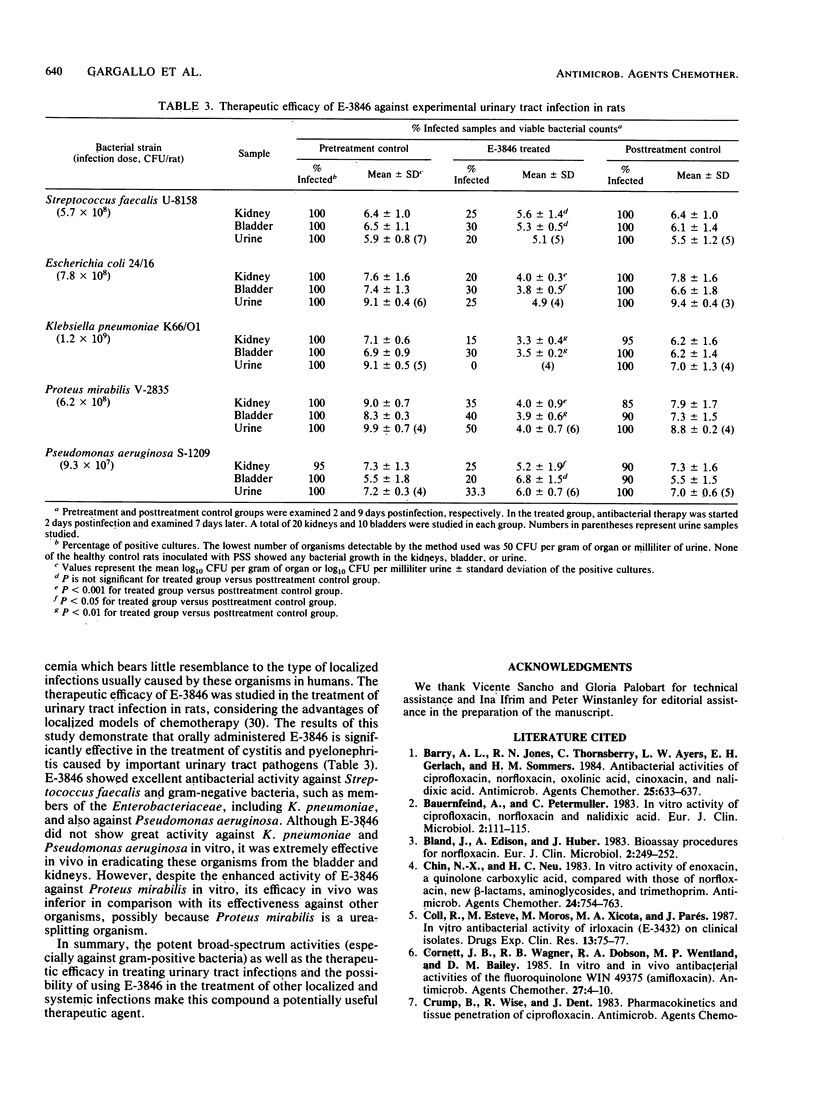
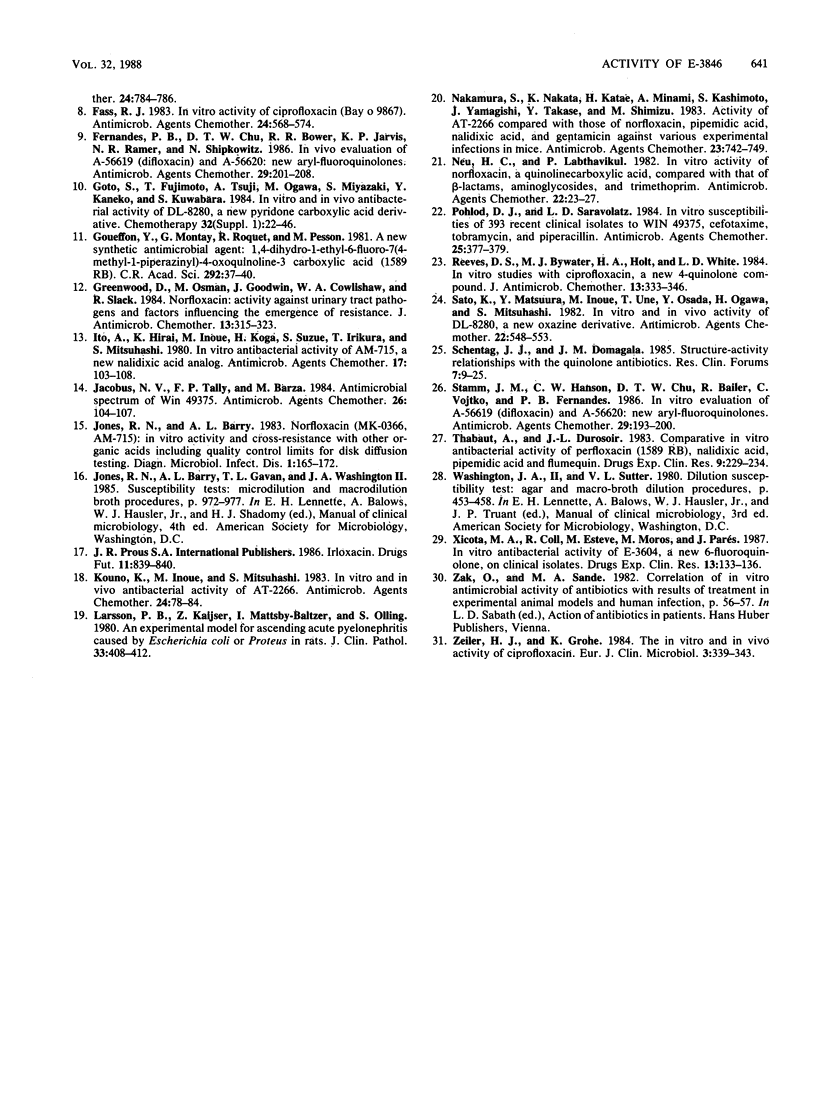
Selected References
These references are in PubMed. This may not be the complete list of references from this article.
- Barry A. L., Jones R. N., Thornsberry C., Ayers L. W., Gerlach E. H., Sommers H. M. Antibacterial activities of ciprofloxacin, norfloxacin, oxolinic acid, cinoxacin, and nalidixic acid. Antimicrob Agents Chemother. 1984 May;25(5):633–637. doi: 10.1128/aac.25.5.633. [DOI] [PMC free article] [PubMed] [Google Scholar]
- Bauernfeind A., Petermüller C. In vitro activity of ciprofloxacin, norfloxacin and nalidixic acid. Eur J Clin Microbiol. 1983 Apr;2(2):111–115. doi: 10.1007/BF02001575. [DOI] [PubMed] [Google Scholar]
- Bland J., Edison A., Huber J. Bioassay procedures for norfloxacin. Eur J Clin Microbiol. 1983 Jun;2(3):249–252. doi: 10.1007/BF02029527. [DOI] [PubMed] [Google Scholar]
- Chin N. X., Neu H. C. In vitro activity of enoxacin, a quinolone carboxylic acid, compared with those of norfloxacin, new beta-lactams, aminoglycosides, and trimethoprim. Antimicrob Agents Chemother. 1983 Nov;24(5):754–763. doi: 10.1128/aac.24.5.754. [DOI] [PMC free article] [PubMed] [Google Scholar]
- Coll R., Esteve M., Moros M., Xicota M. A., Parés J. In vitro antibacterial activity of irloxacin (E-3432) on clinical isolates. Drugs Exp Clin Res. 1987;13(2):75–77. [PubMed] [Google Scholar]
- Cornett J. B., Wagner R. B., Dobson R. A., Wentland M. P., Bailey D. M. In vitro and in vivo antibacterial activities of the fluoroquinolone WIN 49375 (amifloxacin). Antimicrob Agents Chemother. 1985 Jan;27(1):4–10. doi: 10.1128/aac.27.1.4. [DOI] [PMC free article] [PubMed] [Google Scholar]
- Fass R. J. In vitro activity of ciprofloxacin (Bay o 9867). Antimicrob Agents Chemother. 1983 Oct;24(4):568–574. doi: 10.1128/aac.24.4.568. [DOI] [PMC free article] [PubMed] [Google Scholar]
- Fernandes P. B., Chu D. T., Bower R. R., Jarvis K. P., Ramer N. R., Shipkowitz N. In vivo evaluation of A-56619 (difloxacin) and A-56620: new aryl-fluoroquinolones. Antimicrob Agents Chemother. 1986 Feb;29(2):201–208. doi: 10.1128/aac.29.2.201. [DOI] [PMC free article] [PubMed] [Google Scholar]
- Goueffon Y., Montay G., Roquet F., Pesson M. Sur un nouvel antibactérien de synthèse : l'acide éthyl-1 fluoro-6 (méthyl-4 pipérazinyl-1)-7 oxo-4 dihydro-1.4 quinoléine-3 carboxylique (1589 R.B.). C R Seances Acad Sci III. 1981 Jan 5;292(1):37–40. [PubMed] [Google Scholar]
- Greenwood D., Osman M., Goodwin J., Cowlishaw W. A., Slack R. Norfloxacin: activity against urinary tract pathogens and factors influencing the emergence of resistance. J Antimicrob Chemother. 1984 Apr;13(4):315–323. doi: 10.1093/jac/13.4.315. [DOI] [PubMed] [Google Scholar]
- Ito A., Hirai K., Inoue M., Koga H., Suzue S., Irikura T., Mitsuhashi S. In vitro antibacterial activity of AM-715, a new nalidixic acid analog. Antimicrob Agents Chemother. 1980 Feb;17(2):103–108. doi: 10.1128/aac.17.2.103. [DOI] [PMC free article] [PubMed] [Google Scholar]
- Jacobus N. V., Tally F. P., Barza M. Antimicrobial spectrum of Win 49375. Antimicrob Agents Chemother. 1984 Jul;26(1):104–107. doi: 10.1128/aac.26.1.104. [DOI] [PMC free article] [PubMed] [Google Scholar]
- Jones R. N., Barry A. L. Norfloxacin (MK-0366, AM-715): in vitro activity and cross-resistance with other organic acids including quality control limits for disk diffusion testing. Diagn Microbiol Infect Dis. 1983 Jun;1(2):165–172. doi: 10.1016/0732-8893(83)90047-0. [DOI] [PubMed] [Google Scholar]
- Kouno K., Inoue M., Mitsuhashi S. In vitro and in vivo antibacterial activity of AT-2266. Antimicrob Agents Chemother. 1983 Jul;24(1):78–84. doi: 10.1128/aac.24.1.78. [DOI] [PMC free article] [PubMed] [Google Scholar]
- Larsson P., Kaijser B., Baltzer I. M., Olling S. An experimental model for ascending acute pyelonephritis caused by Escherichia coli or proteus in rats. J Clin Pathol. 1980 Apr;33(4):408–412. doi: 10.1136/jcp.33.4.408. [DOI] [PMC free article] [PubMed] [Google Scholar]
- Nakamura S., Nakata K., Katae H., Minami A., Kashimoto S., Yamagishi J., Takase Y., Shimizu M. Activity of AT-2266 compared with those of norfloxacin, pipemidic acid, nalidixic acid, and gentamicin against various experimental infections in mice. Antimicrob Agents Chemother. 1983 May;23(5):742–749. doi: 10.1128/aac.23.5.742. [DOI] [PMC free article] [PubMed] [Google Scholar]
- Neu H. C., Labthavikul P. In vitro activity of norfloxacin, a quinolinecarboxylic acid, compared with that of beta-lactams, aminoglycosides, and trimethoprim. Antimicrob Agents Chemother. 1982 Jul;22(1):23–27. doi: 10.1128/aac.22.1.23. [DOI] [PMC free article] [PubMed] [Google Scholar]
- Pohlod D. J., Saravolatz L. D. In vitro susceptibilities of 393 recent clinical isolates to WIN 49375, cefotaxime, tobramycin, and piperacillin. Antimicrob Agents Chemother. 1984 Mar;25(3):377–379. doi: 10.1128/aac.25.3.377. [DOI] [PMC free article] [PubMed] [Google Scholar]
- Reeves D. S., Bywater M. J., Holt H. A., White L. O. In-vitro studies with ciprofloxacin, a new 4-quinolone compound. J Antimicrob Chemother. 1984 Apr;13(4):333–346. doi: 10.1093/jac/13.4.333. [DOI] [PubMed] [Google Scholar]
- Sato K., Matsuura Y., Inoue M., Une T., Osada Y., Ogawa H., Mitsuhashi S. In vitro and in vivo activity of DL-8280, a new oxazine derivative. Antimicrob Agents Chemother. 1982 Oct;22(4):548–553. doi: 10.1128/aac.22.4.548. [DOI] [PMC free article] [PubMed] [Google Scholar]
- Stamm J. M., Hanson C. W., Chu D. T., Bailer R., Vojtko C., Fernandes P. B. In vitro evaluation of A-56619 (difloxacin) and A-56620: new aryl-fluoroquinolones. Antimicrob Agents Chemother. 1986 Feb;29(2):193–200. doi: 10.1128/aac.29.2.193. [DOI] [PMC free article] [PubMed] [Google Scholar]
- Xicota M. A., Coll R., Esteve M., Moros M., Parés J. In vitro antibacterial activity of E-3604, a new 6-fluoroquinolone, on clinical isolates. Drugs Exp Clin Res. 1987;13(3):133–136. [PubMed] [Google Scholar]
- Zeiler H. J., Grohe K. The in vitro and in vivo activity of ciprofloxacin. Eur J Clin Microbiol. 1984 Aug;3(4):339–343. doi: 10.1007/BF01977490. [DOI] [PubMed] [Google Scholar]


